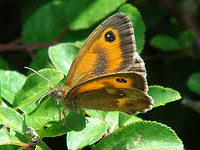 Flight times:
Flight times: 
Description:
This medium-sized butterfly looks more golden in flight than almost any other Brown but is not so bright as to be mistaken for a Fritillary or the Comma. Seen up close, it is easy to identify, although beginners sometimes confuse it with the much larger Meadow Brown. The Gatekeeper's upperwings have broad grey-brown borders enclosing large orange patches, which are especially bright in the males. The males also have a conspicuous dark scent band across the orange on the forewing and are considerably smaller than the females. Both sexes have a large black eyespot usually containing two white pupils near the tip of the forewings, whereas the Meadow Brown's eye has a single pupil. The Gatekeeper also has one, and sometimes several small white dots on the upper hindwing. The undersides are bright mottled brown on the hindwing and dull orange on the forewing, which again bears a distinctive eye with twin pupils. Note also that any dots on the under hindwings are white, whereas those on the Meadow Brown are black.
Adult wingspan: 37-48mm.
Range & Habitat:
This very common butterfly is found throughout much of England and Wales. It inhabits grassy areas and is the typical butterfly of hedgerow and woodland rides of high summer.
It is a common butterfly throughout much of the open habitats on the Park. Numbers were exceptionally low in 1986 and 1987 and this slump was reflected at other sites. It has since recovered and numbers seem to have remained stable.
Grayling - Hipparchia semele
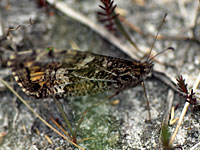 Flight times:
Flight times: 
Description:
This is our largest Brown. The sexes look similar although the female is slightly paler and larger. They always settle with the wings closed, and usually the forewings are tucked out of sight so that only the undersurfaces of the hindwings are generally visible. These are marbled in pale brown and dark grey and light grey, with no clear cut pattern although there is a zigzag boundary halfway across separating darker markings near the body from a paler outer half. There may be a tiny eyespot near the bottom corner. All in all, it looks like a grey bark or dirty sand, and is perfectly camouflaged against the bare spots of ground on which it settles. When the under forewings protrude they reveal a grey border and a brighter, almost orange centre containing two conspicuous black eyespots with white pupils. The upperwings are light brown with bright straw coloured wavy bands and distinctive eyespots, giving the Grayling a richer and brighter appearance in flight than the underwings would suggest, although the overall impression is still of grey. Graylings can be confused with no other species.
Adult wingspan: 51-62mm.
Range & Habitat:
This species occurs throughout much of the British Isles but is distinctly coastal in distribution. It is found in open, dry habitats such as heathland, undercliff, downland, and saltmarsh.
It is generally a scarce butterfly at Durlston and this may be due to the shortage of undisturbed, sparsely vegetated areas.
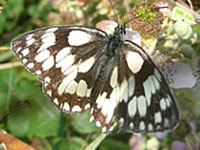 Flight times:
Flight times: 
Description:
This delightful medium-sized butterfly has a clear cut pattern of black and white chequered markings on its wings, very different from our other native Browns, and is not llikely to be confused with White butterflies, since they do not have anywhere near as much black on them. Another difference from the Whites is a series of blue centred black eyespots which are conspicuous, at rest, towards the outer edges of the underwings. The Marbled White's chequered pattern is also recognisable during flight, partly because the wings are flapped very slowly. The ground colour on the underwings varies somewhat from white to pale yellow, and the markings are less distinct, being grey on males and dusky olive-green on the females.
Adult wingspan: 53-58mm.
Range & Habitat:
The butterfly is restricted to chalk and limestone grasslands but can also be found along woodland rides and hedgerows on similar grassy soils. It can be rather common where it occurs.
It is a common butterfly on the Park found on all grassland areas including fallow meadow. Numbers have generally increased which may be a result of the increase in rough, ungrazed grassland.
Flight times: 
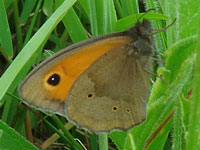
Description:
This is the commonest large Brown butterfly in Britain. The male's upperwings are dusky brown with a blurred black patch from the central forewing to the body. In the corner of each forewing is one small white-pupilled black eyespot, usually surrounded by a circle of dull orange. There may also be a faint orange patch below this. This orange patch and the eyespot are both much larger and more prominent on the female. The Meadow Brown often sits with its wings closed, and the lower hindwing may be all that is visible. This is grey-brown with a slight orange sheen and a zig-zag boundary that divides a darker inner half from a brighter outer half. There may be one or several small black dots in the outer half. When exposed, the lower forewing is seen as a dull orange with a dusky border and a similar eyespot to that on the upperwing.
Both sexes become very faded when old. Depending on their age, several Browns look rather like the Meadow Brown in flight, but none should be confused when seen at rest. Note the lack of eyespots on the upper hindwing and compare with the Ringlet and Gatekeeper.
Adult wingspan: 40-60mm.
Range & Habitat:
This is one of Britain's most widespread and common butterflies. It can be found in large numbers in nearly all grassland habitats.
It is a common butterfly throughout much of the Park. Numbers have steadily increased in recent years and this may be a response to the increase in available foodplants.
Ringlet - Aphantopus hyperantus
Flight times: 
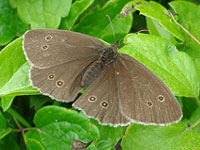
Description:
This medium sized butterfly has dark velvety-brown upperwings that are almost black on the male and only slightly lighter on the female. A fine white fringe runs round the outer edges, making a sharp contrast, and there are usually two inconspicuous little black eyespots near the centre of each wing. When settled, the wings are usually closed, revealing the Ringlet's most distinctive feature - a string of conspicuous eyes with white centres surrounded by black then yellow rings. There are generally five to each hindwing with at least two on the forewings, and they gleam clearly against a dark, slightly bronzed background.
Adult wingspan: 42-52mm.
Range & Habitat:
This species is widely distributed within the British Isles but is absent from north-west England and north Scotland. It inhabits the relatively sheltered areas of tall, occasionally damp, grasslands.
In 2003, a colony was located on the grassy banks of The Gully during June and July. The species was recorded in the same area in 2006 and 2007.
Flight times: 

Description:
Both sexes of this little butterfly are similar and easy to identify. The upperwings are brilliant-shining copper with black marks and borders on the forewings, and copper borders against a black background on the hindwings. The underwings are equally distinctive - the hindwing is grey-brown whilst the forewing is pale orange with black spots.
Everywhere there is a good deal of variation in the size of the black marks on the upperwings. Throughout its range there is a variety that has a row of blue spots on the upper hindwings - these beautiful specimens are rare in most areas.
Nothing in Britain can be confused with this butterfly, either in flight or at rest.
Adult wingspan: 26-40mm.
Range & Habitat:
It is common throughout much of the British Isles but usually occurs in distinct colonies.
The butterfly is generally distributed throughout the Park, although no colonies have been identified as yet. While it is difficult to determine with incomplete data, there may possibly be a seven year cycle.
Small Heath - Coenonympha pamphilus
Flight times: 
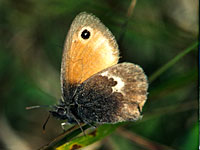
Description:
This is our only small light brown butterfly - female Blues are very much darker, Skippers more golden, and other Browns are considerably larger. The Small Heath always settles with its wings closed, so only the undersides are seen. The upper hindwing is pale grey-brown, with slightly darker patches (but no real pattern) near the body, a blurred white mark halfway out, and faint white dots near the outer edge. The forewing is tucked down in bad weather, but usually protrudes as an orange triangle with grey edges and a conspicuous white-pupilled black eyespot near the top corner. The upperwings are tawny, making the whole butterfly light brown when flying.
Adult wingspan: 33-37mm.
Range & Habitat:
The Small Heath is found in open habitats, such as heathland, downland, and undercliff, throughout the British Isles.
The butterfly is found in most open areas of the Park. It seems to favour Round Down, The Gully, and Durlston Bay landslip. It is distinctly double-brooded at Durlston with the second brood much less numerous than the first. While numbers vary each year, there has been a distinct increase in numbers from 2002 to 2004 in both transects. The reasons for this are unclear.
Flight times: 
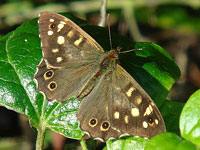
Description:
This medium-sized Brown often basks with its wings open, revealing an unmistakable pattern of creamy-yellow patches on a deep chocolate background. There are three separate black eyes with white pupils in the patches towards the edge of each hindwing and another eye near the top corner of each forewing. The males have slightly smaller and more blurred yellow markings than the females, and in both sexes the patches are a little paler in the summer brood.
The underwings are beautifully patterned in grey and brown, and resemble a dead leaf when the wings are closed. There are faint marks like mould-spots on the lower wing and a conspicuous eyespot at the top corner of the forewing. Note its habit of flying in shady places, where its chequered wings perfectly match the dappled light. No other butterfly is likely to be confused with this species.
Adult wingspan: 46-56mm.
Range & Habitat:
This butterfly is presently expanding its range after a spectacular decline in the early 20th century. It is found throughout much of the southern part of the British Isles and many parts of Scotland but is still absent from many other areas. It never occurs in great numbers. Its main habitat is woodland but it may also be found in gardens and hedgerows where grasses, its foodplant, grow.
The butterfly is relatively common on the Park occurring most frequently along the woodland edge and glade in the east of the Park, and around the more mature stands of scrub in the west.
Flight times: 
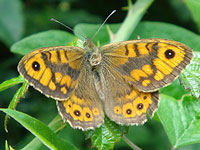
Description:
The Wall Brown (sometimes referred to merely as the Wall) is usually seen basking with its wings open, revealing bright orange upperwings with dark borders, veins and wavy crosslines, and dusky areas near the body. The male also has a stripe of dark scent scales diagonally across the forewing. In both sexes there is a conspicuous white-pupilled black eyespot in the top corner of each forewing, and a row of four smaller eyespots around the lower edge of each hindwing.
The underside of each forewing is a paler version of the upperside, but that of the hindwing is very different . It is pearl grey with brown zigzag lines across it, and a row of six eyespots towards the outer edge, each composed of a white-pupilled black spot surrounded by rings of yellow and brown. The bottom spot often has a double pupil. With its wings closed, the Wall Brown blends beautifully with the patches of bare ground on which it usually sits. In flight, its wings are so golden as to be confused with a Comma, or even a Fritillary, but at rest the eyespots and pattern are unmistakable.
Adult wingspan: 45-53mm.
Range & Habitat:
The Wall is a common butterfly of open grassland habitats, in particular downland. It is present throughout England and Wales.
The butterfly is common on the Park, seemingly preferring sparsely vegetated sites. The species has shown large peaks in some years, namely 1989 and 1999.